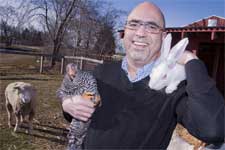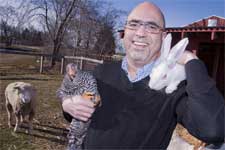 KINGSTON, R.I. – January 3, 2012 – David Serra maintains a veterinary practice in Richmond where he enjoys caring for the dogs and cats and other pets of local residents. But his passion is looking out for the welfare of the animals at the University of Rhode Island, from rats and mice used in research labs to the fish in tanks at the Narragansett Bay Campus and livestock at Peckham Farm.
KINGSTON, R.I. – January 3, 2012 – David Serra maintains a veterinary practice in Richmond where he enjoys caring for the dogs and cats and other pets of local residents. But his passion is looking out for the welfare of the animals at the University of Rhode Island, from rats and mice used in research labs to the fish in tanks at the Narragansett Bay Campus and livestock at Peckham Farm.
“I never remember wanting to be anything but a veterinarian,” said Serra, who grew up in Westerly and now lives in Richmond. “I was born a veterinarian.”
Serra’s commitment to caring for the University’s animals was recognized last month when the Southern New England chapter of the American Association of Laboratory Animal Science named him its Veterinarian of the Year.
The URI attending veterinarian works closely with individual researchers and the University’s Institutional Animal Care and Use Committee to ensure that all animals are cared for and treated appropriately. In this work, he is guided by the federal Animal Welfare Act and the animal welfare policies of the National Science Foundation and the National Institutes of Health, which fund most of the research involving animals.
“Most of what I do is preventive medicine,” Serra explains. “A big part of what I do is to ensure that the diseases inherent to these species don’t gain entrance to the animal colonies on campus. Screening for diseases and vigilance with surveillance are key.”
Serra said that while he looks out for the health of individual animals, the care of laboratory animals is more often described as “herd health.”
“There are very few things that happen to one animal in a cage,” he said. “Whatever is going to happen usually happens to all the animals.”
While advances in technology have led Serra to face new challenges – like the unique issues faced by mice used in transgenic studies – he is proud to note that technology has also resulted in a dramatic decrease in the number of laboratory animals used in research.
“Using new technologies, we can study a great deal about nature before we have to use an animal,” he said. “We’ve refined our approach to how we are going to use animals, and in doing so we’re saving a lot of lives.”
As a result of the strict regulations of the Animal Welfare Act, the U.S. Department of Agriculture conducts unannounced inspections of animal care facilities once or twice a year to ensure that the University is in full compliance.
“The use of animals in research is a highly charged issue, but I don’t think that there will be a time when animals are no longer used,” Serra said. “We should continue to refine and reduce the number of animals used and find alternative methods, but I don’t think they’re ever going to go away entirely.
“Nor should it go away,” he adds. “It should just be done better and better all the time. And if I can help make it better with better oversight of pain and distress, better oversight of nutritional adequacy and environmental enrichment for these animals, and make their lives happier while they’re giving their lives for us, then I’m very happy doing that.”
URI Department of Communications & Marketing photo by Michael Salerno Photography.

